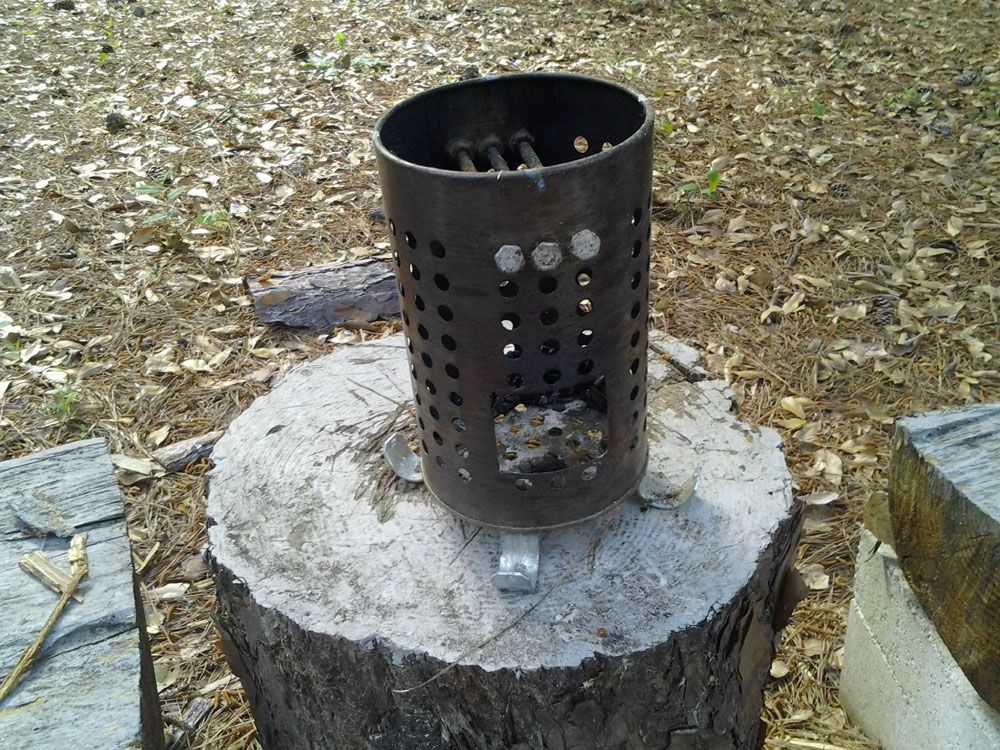Cooking with less energy

I found this article about cooking using less energy. https://www.spsnational.org/sigmapisigma/radiations/spring/2019/making-g...
Pizza is used for the example, and energy inputs all along the line are taking into account, not just the energy used at the point of cooking.
I enjoyed the photo at the bottom of the page, where obviously it is not pizza being prepared. I see in the photo some energy saving items and wonder if you might be able to identify more. If I enlarge the photo, I see farthest from the camera a pressure cooker. Then I see a knife being used, which pleases me because so many cooking sources say to get out a food processer when a people-powered knife will do. There is a "Wonder Bag" type passive insulated cooker; perhaps it is homemade and filled with straw, or crumpled paper, shredded corrugated cardboard, etc. I think in the foreground the shiny tubular thing is a solar oven.
I don't know what some of the other things are. Can you tell me?
mountainmoma
Thu, 03/28/2019 - 00:56
Permalink
what the other things are
There is a biolite cooking set, with light. It is above the solar tube cookers. The biolite burns twigs, and besides cooking on it, you can recharge a cell phone or have a little light, such as in your link The company is here : https://www.bioliteenergy.com/products/campstove-2-bundle?variant=127193... Also in the photo at your link is a little orange device in the foreground which is an infrared temperature reader, you point it at something and press the trigger, and the readout tells you how hot it is. Beside cooking, it is also useful for going around the house and looking for cold spots to see where you are losing heat
Blueberry
Thu, 03/28/2019 - 16:22
Permalink
Hobo Stove
Hobo Stoves have been in use for years by hikers. Using a tin can a bottle opener with a pointed end a coat hanger or stick rods and you have a stove. Very simple light weight to carry if walking the Trail. Will try and post a picture of a upgrade using a stainless steel flat wear drain plus 4- 3/4 inch one hole pipe straps, an 2-3, 6 inch bolts if using 5/16 dia bolts only need 2. Plus 4 bolts 1/4 X 1/2 length. Sorry the picture does not show the feed hole. All parts obtain locally cost under twelve dollars.
Here it is from the front:
meta4
Fri, 03/29/2019 - 21:19
Permalink
Cooking with residual heat
Probably many here know about hayboxes. But for many things like oatmeal you can finish them off simply by folding a dishtowel around the pot or covered bowl. For my extra-thick oats I preheat in microwave 2 minutes then wrap them up for 10 minutes or so. Helps if the bowls are heavy (more mass).
Madam Oh
Mon, 04/01/2019 - 04:04
Permalink
I see you beat me to it!
This is one trick the Japanese have taught me. They have lovely thick stoneware "nabe" pots for making traditional stews, and once you get the contents up to a boil, transfer the pot into a box lined with towels and cover well, and you can get about 30 minutes of cooking that way. Interestingly, certain popular TV programs have started featuring people roughing it or making a little money go a long way, relying on old, nearly forgotten techniques or resources that usually get thrown away. There are people in powerful enough positions in Japan who actually care about resilience. I am so lucky to be here.
David Trammel
Mon, 04/01/2019 - 07:42
Permalink
Big Thick Cookware
I'll have to change what I keep an eye out at thrift stores. Looking at my cupboard, my current plates and bowls are stylish but very thin. Though I mostly cook big on Sundays anymore, and store meals for the rest of the week in my refrigerator, after letting them cool on the countertop.
Summer gets here I'll have to do a few experiments with solar ovens and low energy cooking. I already want to do a experiment of making candles using a solar cooker. I have a couple of boxes of empty pickle and olive jars. And a local candle making supply store, though I don't know where they get their wax from.
lathechuck
Sun, 12/22/2019 - 07:11
Permalink
Low-energy oatmeal preparation
I hardly need to cook it at all, if I let it soak in the refrigerator overnight (with a few raisins and sunflower seeds or chopped walnuts). In the summer, I eat it cold; in the winter, microwave for a couple of minutes and let cool in the oven while I get dressed.
By the way, a crop rotation that includes oats is better for the soil than just corn and beans, so eating more oats is not just good for you, it's good for the farms, and for the planet.